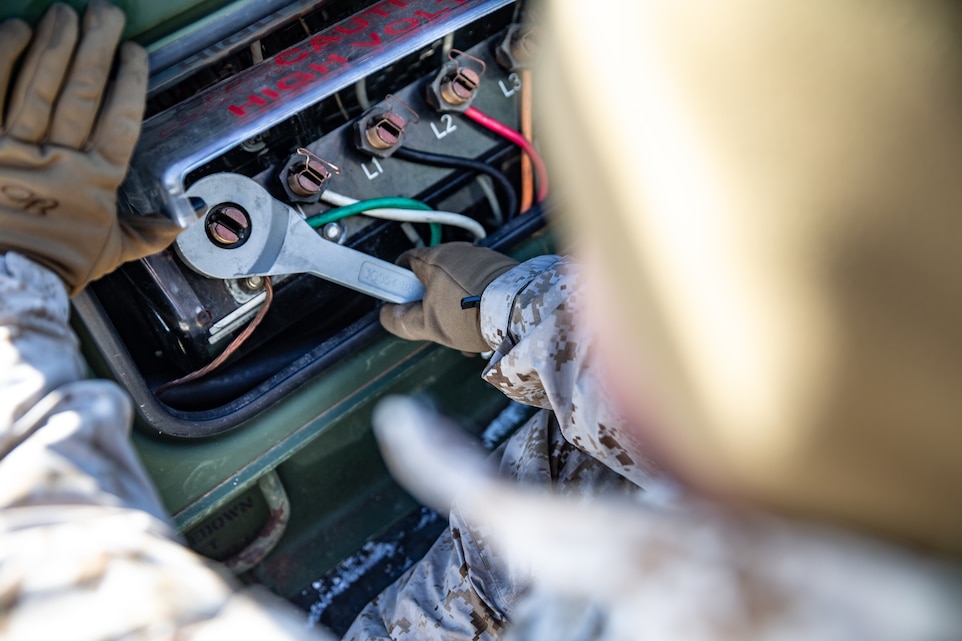
Almost 800 miles from their parent unit in Okinawa, Japan, U.S. Marines with Combat Logistics Company 36 extend 3rd Marine Logistics Group’s reach by attaching small, mobile support teams to units operating across the Indo-Pacific.
Stationed out of Marine Corps Air Station Iwakuni, CLC-36 provides field-level maintenance support and intermediate supply support to III Marine Expeditionary Force.
“Simply stated, intermediate supply and maintenance is the level above what a tactical level unit is equipped and authorized to handle,” explained Capt. Ryan Hughes, CLC-36 Commander.
Hughes went on to clarify that the lowest level tactical units can organically support all maintenance and supply related requirements for equipment they own. However, for more significant repairs or large stock of items, units must seek assistance from intermediate level supply and maintenance like the support provided by CLC-36.
In February 2019, CLC-36 re-aligned to fall under 3rd Supply Battalion as opposed to directly under the higher echelon unit, Combat Logistics Regiment 35.
“This change in structure created a direct conduit to a very resourced battalion that has equipped CLC-36 with the capability to exploit more opportunities to support III MEF units,” stated Hughes. “Our mission remains the same, but thanks to the re-alignment, our mission is re-energized.”
“We practiced operating with a very reduced footprint in order to increase our survivability.” Col. Omar Randall, CLR-37 Commander
Prior to the re-alignment, CLC-36 primarily focused on its garrison mission by supplying and maintaining ground equipment on MCAS Iwakuni, but always had the desire to support more units across the region.
“Because not all III MEF units are on MCAS Iwakuni, the question became, ‘How can we elevate our mission to better support all units in III MEF, not just the ones on MCAS Iwakuni?’,” said Hughes. “After some brainstorming, the answer came in the form of supporting MEF level exercises, executing Maintenance Contact Teams and developing a ‘Military Occupational Specialty Rotation’ that sends CLC-36 Marines as augments to units in III MEF for six months at a time.”
CLC-36 dispatches specialized teams with personnel and equipment catered to each situation or unit in need of support. The concept distributes and expands CLC-36’s support footprint while keeping the smallest, lowest signature.
“This is a capability that is unique to CLC-36 as the company is comprised of personnel that are experts in supply and maintenance,” explained Hughes. “These personnel, paired with our higher command’s ability to requisition equipment or parts needed for MEF exercises and deployments, means that CLC-36 can self-organize and push logistics support to units in a forward deployed status.”
Other units within 3rd MLG also continue to practice and validate their ability to conduct distributed operations. By cross training their Marines to operate across the full spectrum of their specialty, 3rd MLG can deploy the smallest possible units, with the lowest signature, while yielding maximum operational utility.
From Feb. 23 to March 4, 2020 Combat Logistics Regiment 37, 3rd MLG executed their Regimental Field Exercise across Okinawa, Japan. During their Regimental FEX, CLR-37 tested their ability to conduct mobile, forward based operations by distributing their units in multiple locations in the Central Training Area and on Camp Kinser.
“We practiced operating with a very reduced footprint in order to increase our survivability,” said U.S. Marine Corps Col. Omar Randall, CLR-37 Commander.
To further increase survivability and support to distributed operations, Combat Logistics Regiment 3 also practiced sustainment from the sea during their Maritime Prepositioning Force exercise in Guam from Feb. 24 to 29, 2020. During the exercise at Naval Base Guam, CLR-3 Marines offloaded and onloaded equipment from the USNS Dahl (T-AKR-312), the largest MPF ship in the fleet.
The MPF Offload in Guam “was the first time the Dahl had been pier side at Apra Port,” said U.S. Marine Corps Col. Travis Gaines, CLR-3 Commander. During the offload, the Marines “took a normal administratively loaded MPF ship and operationalized it to support future exercises. We not only reconfigured the ship, but also focused the Marines to apply critical thought to test new warfighting concepts and ensure these ships are ready for future tasking.”
Marines use MPFs to preposition gear and equipment in strategic locations around the world in order to supply units with necessary assets at a moment’s notice. The MPF exercise in Guam prepared the Marines to quickly and efficiently mobilize communications gear, equipment and weaponry.
Through testing and validating these distributed operations concepts, 3rd MLG continues to advance their warfighting techniques, improve readiness and most importantly, ‘Sustain the Pacific’.



